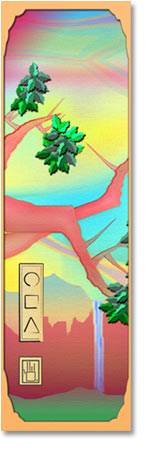On The Way: The Daily Zen Journal
Sayings of Daikaku
Part 1
Daikaku (1203-1268)
Zen practice is not clarifying conceptual distinctions, but throwing away one’s preconceived views along with the sacred texts and all the rest, and then piercing through the layers covering over the spring of self behind them. All of the holy ones have turned within and sought the self and by this went beyond all doubt.
To turn within means all the twenty-four hours and in every situation, to pierce one by one through the layers covering the self, deeper and deeper, to a place which cannot be described.
It is then that thinking comes to an end and making distinctions ceases; wrong views and ideas disappear of themselves without having to be driven forth with; and without being sought the true action and true impulse appear of themselves. It is then one can know the truth of the heart.
The person resolute in the way must from the beginning never lose sight of it, whether in a place of calm or in a place of strife, and must not be clinging to quiet places and shunning those where there is disturbance. If you try to take refuge from trouble by running to some quiet place, you will fall into confusion.
This is the main point of meditation. In the beginning, however, one cannot mount to the treasure in one step. When in sitting meditation there is agitation of thought, then with that very agitated mind seek to find where the agitated thought came from, and who it is that is aware of it.
In this way pressing forward as to the location of the disturbance further and further to the ultimate point, you will find that the agitation does not have any original location, and that the one who is aware of it also is void. This is called taking the search back.
Hearing a sound, take it simply as sound; seeing a form, take it simply as form. Learning how to turn the light back and control vision and how to turn hearing within are things which none of you understand.
In hearing sounds as you do all day long, find out whether it is the sound which comes to the ear, or the ear that goes out to the location of the sound. If it is the sound which comes to the ear, there is no track of its entry. The practitioner of Zen should carefully go into this in silent inquiry.
In silent investigation, with great courage turn the hearing back till hearing comes to an end; purify awareness till awareness becomes empty. Then there will be a perception of things which is immediate without any check to it, and after that, even in a welter of sounds and forms, you will not be swept away by them. Even in a state of darkness and confusion you will be able to find a way. This is the activity of a person of great freedom, and one who has attained the Way.
Whether you are going or staying, sitting or lying down, the whole world is your own self. You must find out whether the mountains, rivers, grass and forests exist in your own mind or exist outside it. Analyze the ten thousand things, dissect them minutely, and when you take this to the limit, you will come to the limitless.
When you search into it, you come to the end of searching where thinking goes no further and distinctions vanish. When you smash the citadel of doubt, then the Buddha is simply yourself.
The true nature is eternal and unchanging, the same and equal in Buddhas and other beings. When wisdom illumines this sameness and equality, there is no appearance of ignorance. The words of the patriarchs are only a tile to knock at the gate; before entering, “see the nature to be Buddha” is the ultimate word, but when inside there is no concern with any form, and “to be Buddha” has no meaning.
Daikaku (1203-1268)
Excerpted from Zen and the Ways by Trevor Leggett




Daikaku is the formal title of a Chinese monk named Tao Lung. He came to Japan in 1246 to teach with very little knowledge of Japanese in the first years. The above selection speaks to the heart of practice and as is the case with many selections, it is full to the brim of the beginning steps as well as a very evocative description of the “end” of practice. The question for us in these times is how many of us will take even one piece and apply ourselves to explore these depths?
Calmness
A proverb says that sages accomplish the ultimate human attainment based on calmness. The ultimate attainment is great balance as a human being. Sages are based in calmness, not because they think calmness is good and so they focus on it, but because nothing disturbs their minds. They are naturally calm without seeking calmness.
People seeking calmness today have not gotten the true tradition. They all say to chain the monkey-mind tightly and tether the idea-horse fast. When they find they cannot chain or tether it down, finally they say the mind is ultimately ungraspable and thus calm. They do not even reflect that this practice is a mistake that is due to failure to attain knowledge.
When you attain knowledge, you are clear. When you are clear, you see that all truths in the world are settled and do not admit of any subjective ideas at all. That is known as having stability after knowing where to stop. After you are stable, you can be calm. After you are calm, you can be at peace.
– The Cultivation of Realization (1739); author unknown; taken from Taoist Meditation translated by Thomas Cleary
Calmly viewing the Blue Sky,
Elana, Scribe for Daily Zen